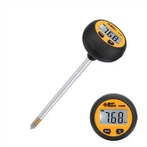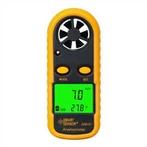Probe Selection and Use of Anemometers
I. Probe selection for anemometers
Usually there are three methods to measure wind speed: thermal probe, impeller probe, and Bittor. How can we choose the most suitable instrument for our use when measuring wind speed? For what applications are each of these three measurement methods suitable?
In the 0 to 100m/s flow velocity measurement range, we can be divided into three zones: low speed: 0 to 5m/s; medium speed: 5 to 40m/s; high speed: 40 to 100m/s. Anemometer's thermal probe is used for 0 to 5m/s measurement; anemometer's impeller probe has the best effect in measuring the flow velocity from 5 to 40m/s; and the use of Pitot tube can be used to get the best results in the high speed range.
1. Thermal probes provide accurate measurements of wind speeds in the range of 0 to 30 m/s.
2. Impeller probe can choose the impeller diameter, different sizes of the impeller have different applications. Such as the choice of 100mm diameter impeller can be measured 100mm diameter circular area of the average wind speed. In addition, the impeller probe can also be attached to the cover, to achieve the effect of measuring the air volume of small outlets.
3. Bitou is generally used to measure the wind speed of the pipeline, suitable for large wind speed, generally less than 5m / s wind speed are not recommended to use Bitou.
An additional criterion for the correct selection of anemometer probes is the temperature: usually the thermal sensor of anemometers is used at temperatures of about -20~70˚C. Ordinary impeller probes are also used at temperatures of about -20~70˚C, but impeller probes can be specially made to withstand temperatures of up to 350˚C. Pitot tubes have the widest range of temperatures and even the most common probes can withstand temperatures up to 600˚C.
Working Principle of Different Anemometers
1. Thermal Probes for Anemometers
Thermal probes are based on the fact that the cold shock airflow carries away the heat from the thermal element with the help of a regulating switch that keeps the temperature constant, then the regulating current is proportional to the flow rate. When using a thermal probe in turbulent flow, air currents from all directions simultaneously impinge on the thermal element, thus affecting the accuracy of the measurement results.
When measuring in turbulence, the thermal anemometer flow rate sensor tends to show a higher value than the impeller type probe. The above phenomenon can be observed during duct measurements. Depending on the different designs used to manage duct turbulence, they can occur even at low speeds. Therefore, the anemometer measurement process should be carried out in a straight part of the duct. The starting point of the straight section should be at least 10 x D (D = pipe diameter in CM) away in front of the measurement point; the end point should be at least 4 x D behind the measurement point. The fluid section shall not be obstructed in any way. (corners, heavy overhangs, objects, etc.)
2. Impeller Probe of Anemometer
The working principle of the impeller probe of anemometer is based on the conversion of rotation into electrical signals, first through a proximity inductor, the rotation of the impeller "counting" and generating a pulse series, and then converted and processed by the detector, you can get the value of rotational speed. The large diameter probes (60mm, 100mm) of the anemometers are suitable for measuring turbulent flows with small or medium velocity (e.g. at the outlet of pipelines). The small diameter probes of the anemometers are more suitable for measuring airflow in ducts whose cross-section is more than 100 times the cross-sectional area of the probe.






